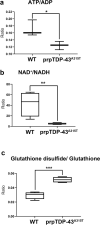Mitochondrial dysregulation occurs early in ALS motor cortex with TDP-43 pathology and suggests maintaining NAD+ balance as a therapeutic strategy
- PMID: 35277554
- PMCID: PMC8917163
- DOI: 10.1038/s41598-022-08068-5
Mitochondrial dysregulation occurs early in ALS motor cortex with TDP-43 pathology and suggests maintaining NAD+ balance as a therapeutic strategy
Abstract
Mitochondrial defects result in dysregulation of metabolomics and energy homeostasis that are detected in upper motor neurons (UMNs) with TDP-43 pathology, a pathology that is predominantly present in both familial and sporadic cases of amyotrophic lateral sclerosis (ALS). While same mitochondrial problems are present in the UMNs of ALS patients with TDP-43 pathology and UMNs of TDP-43 mouse models, and since pathologies are shared at a cellular level, regardless of species, we first analyzed the metabolite profile of both healthy and diseased motor cortex to investigate whether metabolomic changes occur with respect to TDP-43 pathology. High-performance liquid chromatography, high-resolution mass spectrometry and tandem mass spectrometry (HPLC-MS/MS) for metabolite profiling began to suggest that reduced levels of NAD+ is one of the underlying causes of metabolomic problems. Since nicotinamide mononucleotide (NMN) was reported to restore NAD+ levels, we next investigated whether NMN treatment would improve the health of diseased corticospinal motor neurons (CSMN, a.k.a. UMN in mice). prpTDP-43A315T-UeGFP mice, the CSMN reporter line with TDP-43 pathology, allowed cell-type specific responses of CSMN to NMN treatment to be assessed in vitro. Our results show that metabolomic defects occur early in ALS motor cortex and establishing NAD+ balance could offer therapeutic benefit to UMNs with TDP-43 pathology.
© 2022. The Author(s).
Conflict of interest statement
The authors declare no competing interests.
Figures






Similar articles
-
MCP1-CCR2 and neuroinflammation in the ALS motor cortex with TDP-43 pathology.J Neuroinflammation. 2019 Oct 30;16(1):196. doi: 10.1186/s12974-019-1589-y. J Neuroinflammation. 2019. PMID: 31666087 Free PMC article.
-
SBT-272 improves TDP-43 pathology in ALS upper motor neurons by modulating mitochondrial integrity, motility, and function.Neurobiol Dis. 2023 Mar;178:106022. doi: 10.1016/j.nbd.2023.106022. Epub 2023 Jan 27. Neurobiol Dis. 2023. PMID: 36716828
-
Upper motor neurons are a target for gene therapy and UCHL1 is necessary and sufficient to improve cellular integrity of diseased upper motor neurons.Gene Ther. 2022 Apr;29(3-4):178-192. doi: 10.1038/s41434-021-00303-4. Epub 2021 Dec 2. Gene Ther. 2022. PMID: 34853443 Free PMC article.
-
The molecular link between inefficient GluA2 Q/R site-RNA editing and TDP-43 pathology in motor neurons of sporadic amyotrophic lateral sclerosis patients.Brain Res. 2014 Oct 10;1584:28-38. doi: 10.1016/j.brainres.2013.12.011. Epub 2013 Dec 16. Brain Res. 2014. PMID: 24355598 Review.
-
A novel hypothesis on metal dyshomeostasis and mitochondrial dysfunction in amyotrophic lateral sclerosis: Potential pathogenetic mechanism and therapeutic implications.Eur J Pharmacol. 2021 Feb 5;892:173737. doi: 10.1016/j.ejphar.2020.173737. Epub 2020 Nov 19. Eur J Pharmacol. 2021. PMID: 33220280 Review.
Cited by
-
Integrated Omic Analysis Delineates Pathways Modulating Toxic TDP-43 Protein Aggregates in Amyotrophic Lateral Sclerosis.Cells. 2023 Apr 24;12(9):1228. doi: 10.3390/cells12091228. Cells. 2023. PMID: 37174628 Free PMC article.
-
Mitochondria: A Promising Convergent Target for the Treatment of Amyotrophic Lateral Sclerosis.Cells. 2024 Jan 29;13(3):248. doi: 10.3390/cells13030248. Cells. 2024. PMID: 38334639 Free PMC article. Review.
-
Biomarkers for Managing Neurodegenerative Diseases.Biomolecules. 2024 Mar 26;14(4):398. doi: 10.3390/biom14040398. Biomolecules. 2024. PMID: 38672416 Free PMC article. Review.
-
scFv intrabody targeting wildtype TDP-43 presents protective effects in a cellular model of TDP-43 proteinopathy.PLoS One. 2025 Aug 4;20(8):e0322021. doi: 10.1371/journal.pone.0322021. eCollection 2025. PLoS One. 2025. PMID: 40758691 Free PMC article.
-
Altered Metabolism in Motor Neuron Diseases: Mechanism and Potential Therapeutic Target.Cells. 2023 Jun 2;12(11):1536. doi: 10.3390/cells12111536. Cells. 2023. PMID: 37296656 Free PMC article. Review.
References
Publication types
MeSH terms
Substances
Grants and funding
LinkOut - more resources
Full Text Sources
Medical
Molecular Biology Databases
Miscellaneous

